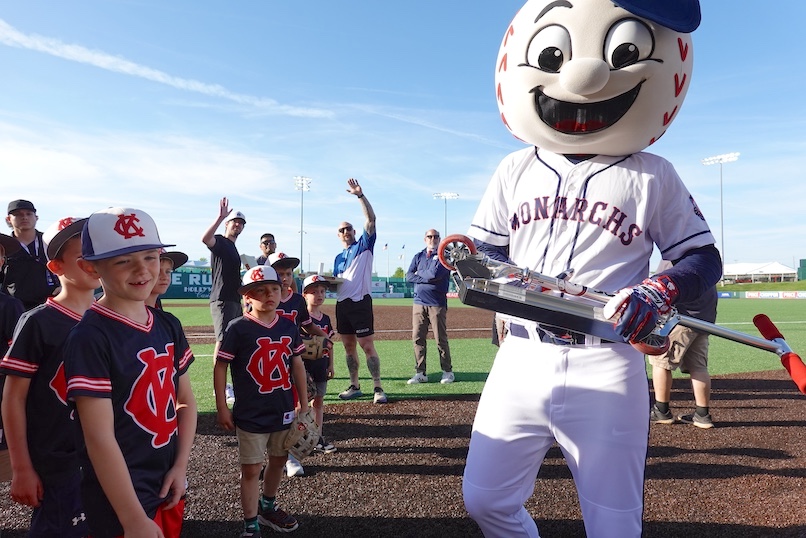
Monty the Monarch welcomes local Little Leaguers to opening day festivities of the 2025 baseball season. Photo by David DeVoss
It was the opening game of the baseball season and the atmosphere at Legends Field, home of the Kansas City Monarchs, resembles that of a carnival. Four skydivers dressed in bright primary colors started the festivities by parachuting onto center field. Action then shifts to the infield, where a handful of Little Leaguers, their mouths agape, stand in awe of team mascot Monty the Monarch’s enormous baseball-shaped head. Meanwhile, multi-generational families packing the grandstand rise in unison to sing Lee Greenwood’s Proud to Be an American, the national anthem of middle class America. The moment the last stanza concludes with the line, “’Cause there ain’t no doubt I love this land! God bless the U.S.A.,” Senior baby boomers start to head toward the Home Plate Bar for margaritas while their progeny, now millennial parents, begin searching for their children somersaulting down the grassy slope above right field.
“Perched on the top step of the Monarchs’ dugout, starting pitcher Julian Garcia, 29, surveys the boisterous crowd as he prepares to take the mound and throw his first pitch. “The Monarchs have a great fan base,” he smiles. “In this ballpark you really get to know the people who attend our games.”

Kansas City Monarch pitcher Julian Garcia, 29, arrives early at Legends Field to prepare for the season opener. Garcia spent seven years in the Philadelphia Phillies minor league system before being released. He joined the Monarchs as a relief pitcher in 2024 and today is a starter. Photo by David DeVoss
The Monarchs’ name has been around under various owners for more than a century. During the early 20th century, it was one of the most successful organizations in the Negro Leagues. It nurtured baseball immortals like Satchel Paige and Jackie Robinson, the player who broke major league baseball’s color barrier in 1947 by signing a contract with the Brooklyn Dodgers. That team no longer exists, but today the name lives on in the American Association, an unaffiliated minor league whose 12 teams call towns like Winnipeg, Fargo, and Sioux City home. It’s a hardscrabble league whose players are constantly striving to move up the baseball ladder. “If you’re released from this league,” sighs Garcia, “it’s easy to be lost and forgotten. We play hard because every player knows he has an expiration date.”
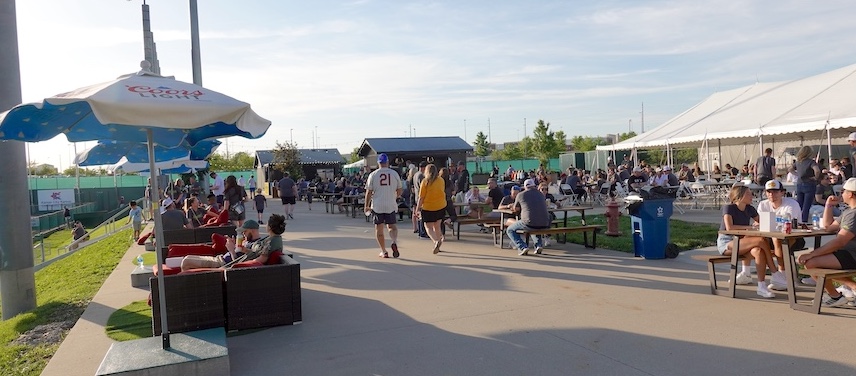
Above the baseball field where the Monarchs play an informal seating area runs around the outfield where fans can socialize and sorta watch the game in a relaxed atmosphere. The grassy area on the left is where many children play during the game. Photo by David DeVoss
The Place To Be
The Monarchs have won four American Association championships, but their popularity stems from a ballpark ambience cultivated by team owner Mark Brandmeyer. Saturday is Autograph Night, where Monarch players spend two hours signing autographs for up to 1,000 fans. It is bookended by Fireworks Friday and Giveaway Sunday, where every ticket holder receives a bobble-headed figurine or water bottle. There’s a Jurassic Park Night, a Ted Lasso Night, and Kansas Swiftie Monarchs Night when local dads and their daughters enjoy Taylor Swift songs. There’s even a special night for Boy Scouts, 400 of whom are invited onto the field after the game to watch a Harry Potter movie.
There are two Kansas Cities, separated by the Missouri River and the state border running between Kansas and Missouri. The Monarchs play in Kansas City, Kansas. Affectionately known as “KCK” by its 153,000 residents, it was founded by Catholic and Orthodox immigrants from Croatia, Slovenia and Serbia, whose Gothic Revival churches still define the skyline of the city’s Strawberry Hill neighborhood.
Play Ball
Kansas City has a Major League Baseball franchise, the Royals. It plays at 38,000-seat Kauffman Stadium east of the state line in Kansas City, Missouri (pop. 509,000). Since joining the American League in 1969, the Royals have repeatedly gone to the World Series, which they won as recently as 2015. The highway leading to the stadium is named after the Royals’ All Star third baseman, George Brett.

Kansas City Royals fans come to Kauffman Stadium to see the home team play the visiting Boston Red Sox. There’s plenty of cheering when the Royals score a run, but not as much frivolity as exists at a minor league game. Photo by David DeVoss
Operating out of 6,600-seat Legends Field, the Monarchs can’t match the Royals in attendance. But Mark Brandmeyer isn’t worried. “We have a beautiful stadium with atmosphere and no nosebleed section like the Royals,” he boasts. “Parents who take four children to a Royals game will spend $500. Our food is just as good but less expensive, and parking is free.”
While it’s true Missouri’s Kauffman Stadium is more expensive than Kansas’ Legends Field – and you will pay $30 for parking – experiencing the contrast between major and minor league baseball is worth the investment. Once inside “the K,” be sure to visit the Royals’ fascinating, and free, museum. Organized baseball arrived in KC in 1884, five years before Kansas City even got its name, and a century and a half of athletic accomplishments by various teams are well documented. Once the game begins, however, it’s apparent these fans came to watch the game. Most tend to stay seated and focus their energy on the Royals’ opponent for the evening, the Boston Red Sox.
Gone But Not Forgotten
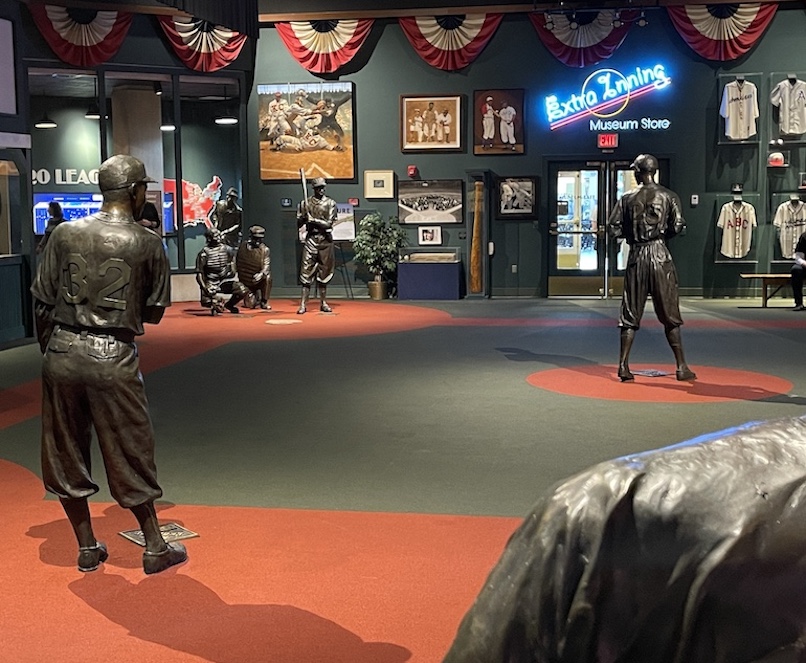
Located in Kansas City’s historic jazz district, the Negro Leagues Baseball Museum celebrates the history of African American baseball. Photo by David DeVoss
If you decide to attend a Royals game, be sure to also visit the Negro Leagues Baseball Museum. Located southeast of downtown in a neighborhood famous for jazz and blues clubs, the museum owns the KC Monarchs name, which in 1920 it leased to Mark Brandmeyer to keep the Monarchs’ memory alive. The marketing is a win for both sides since the name represents competence, continuity, and respect for the community in which the modern Monarchs play. “Baseball is our ‘National Pastime’ because the game always has reflected our social values,” explains NLBM president Bob Kendrick. “The racial integration of baseball in 1947 began a process that led to the civil rights movement and the eventual integration of American society.” The NLBM is full of exhibits discussing Negro League teams and the eras in which they played. But a quote from a Kansas City Star sports editor hanging on a wall says it all: “Admittedly, life would have gone on in Kansas City without baseball….But who would want to live in a city without a soul?”
Do Kansas City baseball fans prefer entertainment or competition? Since Kauffman Stadium is more than six times the size of Legends Field, it’s hard to say based on the number of tickets sold. But those who think winning is everything should take note: At the midpoint of the 2025 baseball season, the Royals had won 48% of their games while the Monarchs’ winning percentage stood at 61.2%.
Meat Me In Kansas City
In Kansas City, baseball is the main summer attraction, but the dual cities’ favorite pastime is barbecue. Texas, the two Carolinas, and the city of St. Louis spend enormous sums promoting their saucy barbecues. But meataholics generally agree that Kansas City BBQ is North America’s best.

The Rally House in the Legends Mall celebrates the styles and products of Kansas City. The center of the store is devoted to a large assortment of clothes and condiments celebrating Kansas City barbecue. Photo by David DeVoss
Local entrepreneurs survive by selling what consumers want to buy. Los Angeles gift shops flog Hollywood and Los Angeles Dodgers merchandise, while Texas emporia feature western wear and football attire. As for North and South Carolina, they remain locked in interminable debate over whether vinegar or mustard makes the best BBQ sauce. In Kansas City, prime retail spots are set aside to sell barbecue sauces, spices to rub on pork ribs, recipe books, funny aprons and grilling implements.
Where can you buy the best BBQ in Kansas City? The question invites prolonged discussion. For me, the best BBQ is served at Joe’s Kansas City Bar-B-Que on West 47th Avenue in KCK. Located in an old gasoline station on the corner of West 47th and Mission Rd, Joe’s is best identified by the line of customers waiting to order racks of smoky ribs or plates of charred “burnt ends” cut from the marbleized point of a brisket.
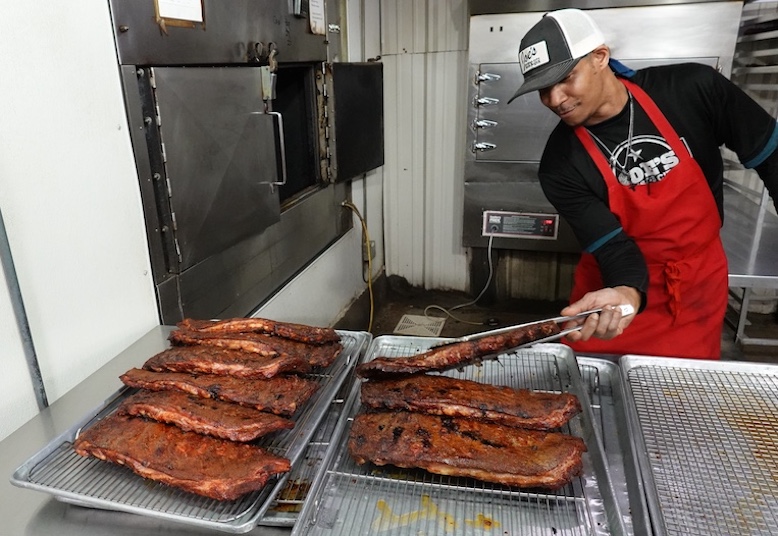
Barbecue pork ribs straight from the smoker at Joe’s Kansas City Bar-B-Que. Joe’s barbecue cooks start smoking meat at 4 am and by 10 pm on a Saturday will have served 1,000 people some of KC’s best BBQ. Photo by David DeVoss
From Burnt Ends to Banana Pudding
Although the place is packed to capacity on a Thursday night, manager Lane Dougherty exudes tranquility as he assembles a sandwich of pulled pork and sliced sausage called Hog Heaven. Also on the serving board is an open-faced turkey on Texas toast with spicy slaw called the Lean-n-Mean and a plate piled with pulled pork, pepper jack cheese, and fried jalapeños called The Rocket Pig. “We have between 500 and 1,000 people a day who come here to eat, and there’s never any waiting,” says Dougherty. “In terms of bar-b-que, we’re the Little Engine That Could.”
Speaking of trains, one of the more bizarre places to grab a bite in KCK is Fritz’s, a burger, breakfast and sandwich shop a few miles West of Strawberry Hill. Fritz’s serves good food at a fair price, but the real reason to go is to see burgers and fries being delivered to every table by electric trains, which zip around the diner on elevated rails until they arrive at the correct table.
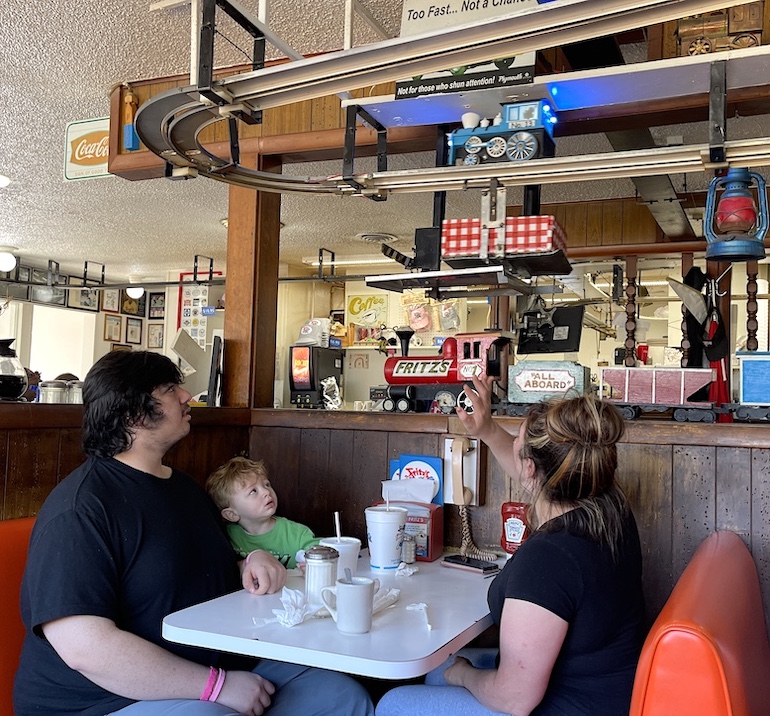
Fritz’s specializes in hamburgers, hot dogs, fried chicken and chili. The food is brought direct to you, not by a waitress, but by a model train locomative that will stop and lower your order to your table before chugging back to the kitchen. Photo by David DeVoss
Most states and large cities operate outdoor historic parks designed to showcase the architecture, industry, and commerce of decades past. Families traveling with children who pass through KCK on the weekend should consider visiting the National Agricultural Center and Hall of Fame. A 20-minute drive from KCK to Bonner Springs leads to a 19th-century village that includes a pioneer general store, blacksmith shop, an 1890s farm residence, a one-room schoolhouse built in 1917, and an 1887 railroad depot once used for sheep but now serving grade schoolers who can ride through the park on a miniature train.
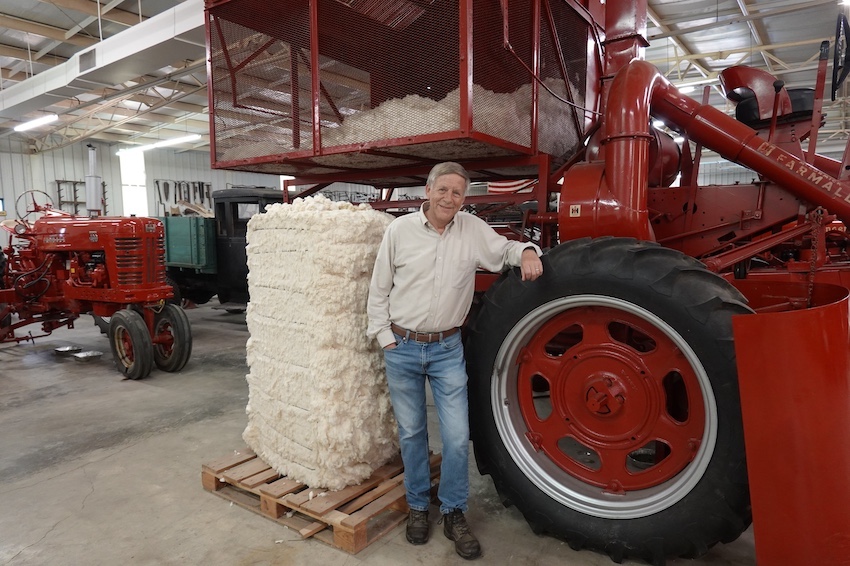
National Agricultural Center and Hall of Fame president David Hurrelbrink stands beside an IH Model 14A Cotton Picker in the Center’s Museum of Farming. The machine could pick eight acres of cotton a day allowing farms in the South and Midwest to become more efficient. Photo by David DeVoss
Remember the U-shaped Taco
The Agricultural Hall of Fame has 43 honorees who range from Norman Borlaug, the Nobel Prize winner whose plant genetics research led to the invention of miracle rice, to John Deere, the manufacturer of agricultural machinery(steel plow and tractor) that made Midwest farming profitable. Also on the wall of honor: the inventor of the U-shaped taco and the inventor of canned vegetables.
About 12% of the 20,000 people who visit the National Agriculture Center every year are children. Call ahead to see if your vacation coincides with one of the special weekends where docents try to explain bizarre historic devices like washboards and clothes pins.
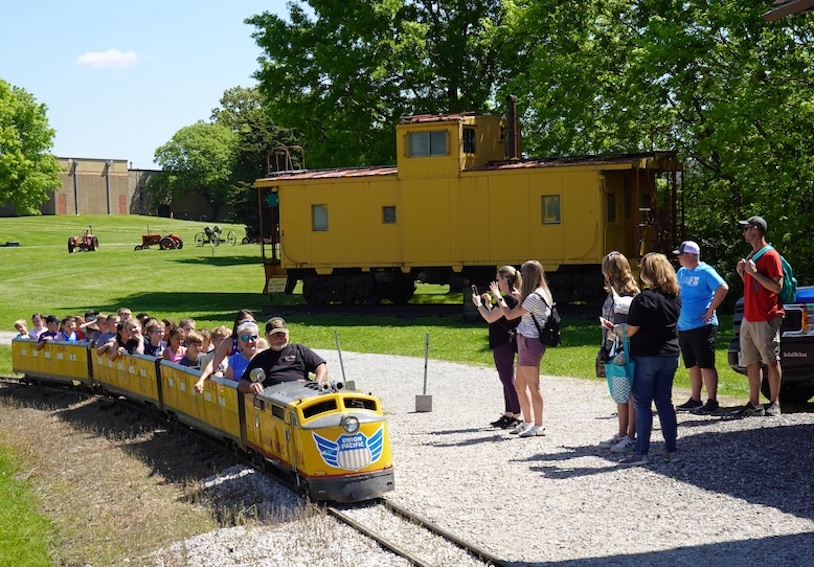
Back in 1887, the Morris Livestock Depot handled mostly sheep transported on the Santa Fe Railroad. In 1987 the old depot was moved to the National Agricultural Center near Bonner Springs, KS where it today transports school children on a model train. Photo by David DeVoss
Going to Kansas City?
Clothing outlet malls are usually clustered outside municipalities alongside interstate highways. But in KCK’s Village West neighborhood, brand name clothing at a discount price can be found right across the street from the Monarchs’ Legends Field at the Legends Outlet Mall. Bargain-priced fashion outlets from designers like Michael Kors, Kate Spade, Vera Bradley, Ralph Lauren, and Tommy Hilfiger are located next to lively pubs, sophisticated restaurants, and movie theaters. The commercial assemblage is such that the mall has become the top tourist destination in the entire state of Kansas.
Once you’ve concluded several hours of shopping and had an opportunity to calculate your savings on the clothing purchased, consioder stopping for dinner at Jazz. This place does not serve barbecue. It offers the best the best New Orleans cuisine in LC. Notice I did not say cajun food. Jazz is far more upscale.Think blackened catfish, charbroiled oysters and shrimp Étouffée.
The memory of great KC barbecue travels better than leftover ribs. If you want to take home the taste of KCK, make your last stop Krizman’s Sausage. Operated since 1939 in the Strawberry Hill section of KCK, this family owned sausage maker produces some of the city’s best smoked knackwurst, andouille, lamb sausage and hard salami. The family member serving you will happily vacuum pack your orde .![]()
David DeVoss is the editor and senior correspondent of the East-West News Service.

